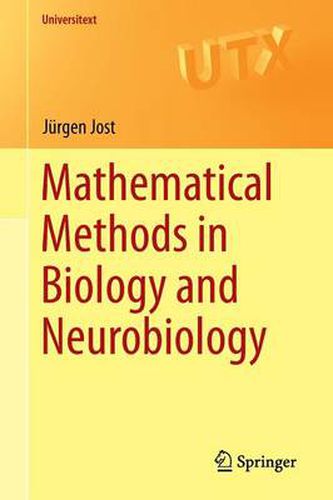Readings Newsletter
Become a Readings Member to make your shopping experience even easier.
Sign in or sign up for free!
You’re not far away from qualifying for FREE standard shipping within Australia
You’ve qualified for FREE standard shipping within Australia
The cart is loading…






This title is printed to order. This book may have been self-published. If so, we cannot guarantee the quality of the content. In the main most books will have gone through the editing process however some may not. We therefore suggest that you be aware of this before ordering this book. If in doubt check either the author or publisher’s details as we are unable to accept any returns unless they are faulty. Please contact us if you have any questions.
Mathematical models can be used to meet many of the challenges and opportunities offered by modern biology. The description of biological phenomena requires a range of mathematical theories. This is the case particularly for the emerging field of systems biology. Mathematical Methods in Biology and Neurobiology introduces and develops these mathematical structures and methods in a systematic manner. It studies:
* discrete structures and graph theory
* stochastic processes * dynamical systems and partial differential equations
* optimization and the calculus of variations.
The biological applications range from molecular to evolutionary and ecological levels, for example:
* cellular reaction kinetics and gene regulation * biological pattern formation and chemotaxis * the biophysics and dynamics of neurons
* the coding of information in neuronal systems * phylogenetic tree reconstruction * branching processes and population genetics * optimal resource allocation * sexual recombination
* the interaction of species.
Written by one of the most experienced and successful authors of advanced mathematical textbooks, this book stands apart for the wide range of mathematical tools that are featured. It will be useful for graduate students and researchers in mathematics and physics that want a comprehensive overview and a working knowledge of the mathematical tools that can be applied in biology. It will also be useful for biologists with some mathematical background that want to learn more about the mathematical methods available to deal with biological structures and data.
$9.00 standard shipping within Australia
FREE standard shipping within Australia for orders over $100.00
Express & International shipping calculated at checkout
This title is printed to order. This book may have been self-published. If so, we cannot guarantee the quality of the content. In the main most books will have gone through the editing process however some may not. We therefore suggest that you be aware of this before ordering this book. If in doubt check either the author or publisher’s details as we are unable to accept any returns unless they are faulty. Please contact us if you have any questions.
Mathematical models can be used to meet many of the challenges and opportunities offered by modern biology. The description of biological phenomena requires a range of mathematical theories. This is the case particularly for the emerging field of systems biology. Mathematical Methods in Biology and Neurobiology introduces and develops these mathematical structures and methods in a systematic manner. It studies:
* discrete structures and graph theory
* stochastic processes * dynamical systems and partial differential equations
* optimization and the calculus of variations.
The biological applications range from molecular to evolutionary and ecological levels, for example:
* cellular reaction kinetics and gene regulation * biological pattern formation and chemotaxis * the biophysics and dynamics of neurons
* the coding of information in neuronal systems * phylogenetic tree reconstruction * branching processes and population genetics * optimal resource allocation * sexual recombination
* the interaction of species.
Written by one of the most experienced and successful authors of advanced mathematical textbooks, this book stands apart for the wide range of mathematical tools that are featured. It will be useful for graduate students and researchers in mathematics and physics that want a comprehensive overview and a working knowledge of the mathematical tools that can be applied in biology. It will also be useful for biologists with some mathematical background that want to learn more about the mathematical methods available to deal with biological structures and data.